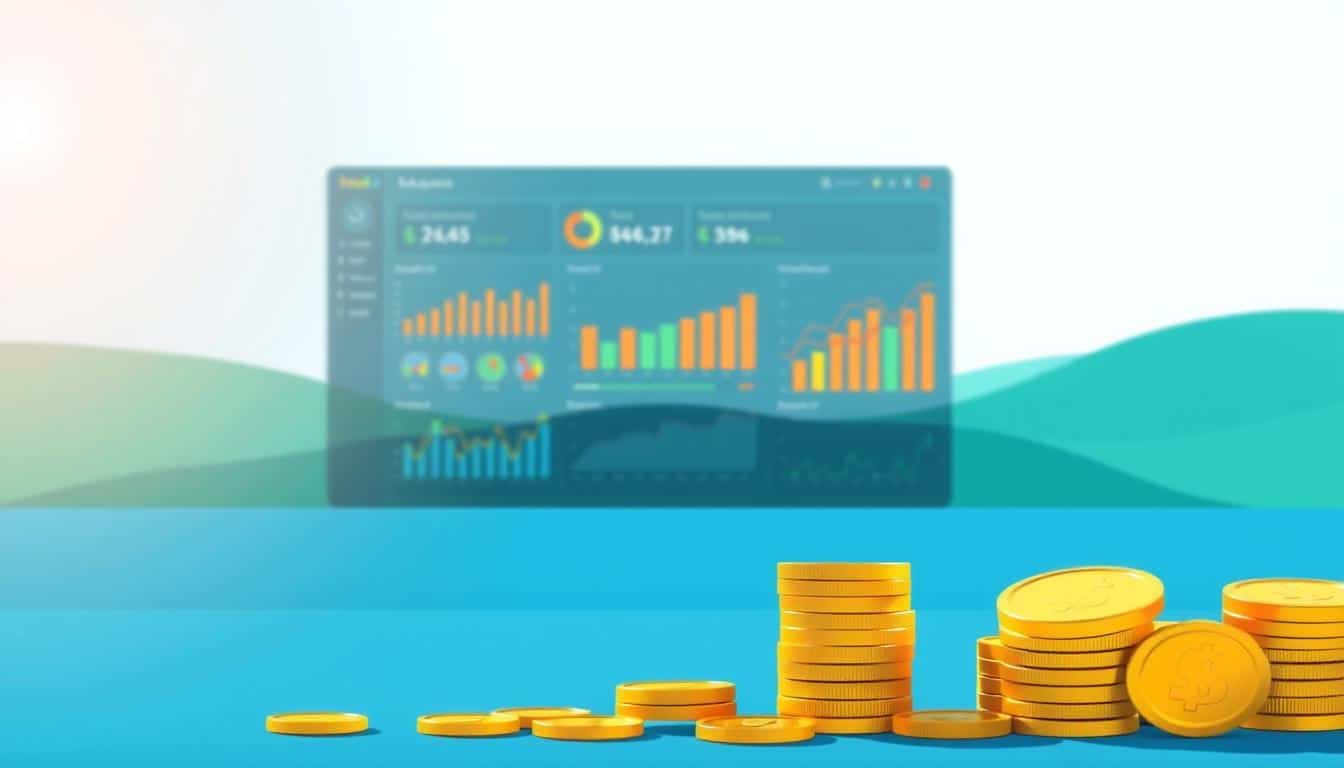Anúncios
Welcome to a 2025 tax guide focused on strategies that let you keep more of your money. This section aims to give easy steps for tax planning in 2025. That way, you can pay less in taxes, get better tax refunds, and manage your money smarter all year.
This guide helps people who earn wages, invest, run small businesses, work for themselves, own rental properties, or are going through big life changes like getting married or selling a house. You’ll learn ways to lower your taxes, cut or delay capital gains, and make the most of retirement and savings accounts that offer tax benefits.
Anúncios
Here’s a quick guide: updates on tax laws and deadlines, how to manage retirement and investments, learn about deductions and credits, rules for small businesses, real estate tips, info on HSAs and 529 plans, end-of-year strategies, keeping good records, and advice on when to see a CPA. The guide is straightforward and user-friendly. It suggests actions like checking your withholdings, adjusting payments, and getting a tax check-up for complex situations.
Anúncios
Key Takeaways
- Start tax planning for 2025 early to maximize returns and avoid surprises.
- Use retirement contributions and HSAs to lower your taxable income.
- Think about when to take capital gains and use tax-loss harvesting in investment accounts.
- Keep track of business expenses and home office deductions to prevent audit issues.
- Check your withholding and estimated payments, and see a CPA for tricky cases.
Overview of 2025 Tax Changes Affecting Individuals
In 2025, new tax rules and adjustments for inflation will impact individual tax planning and filing. This guide highlights the key updates, critical IRS announcements, and steps for taxpayers to take before submitting their taxes.
New laws from Congress will change some tax credits, income levels, and how certain transactions are reported in 2025. It’s crucial to check official IRS or Treasury sources for the latest tax law updates before taking action.
The main deadlines for filing taxes are still around mid-April for most people. There are also dates throughout the year for estimated tax payments. Deadlines may change due to weekends, holidays, and emergencies. Remember, state deadlines might be different from the federal ones.
There are updates to form 1099 reporting and new rules for digital assets. Keep an eye on IRS announcements for the final details on reporting and potential penalties.
Inflation adjustments: standard deduction and tax brackets
The IRS adjusts amounts for inflation each year. For 2025, both the standard deduction and tax bracket thresholds will increase. This helps prevent taxpayers from being pushed into higher tax brackets.
Expect moderate increases for the standard deduction for single and married filers. The final numbers will be in the IRS’s yearly announcement. Tax brackets for 2025 will adjust too, possibly keeping some people from entering higher tax rates.
How new rules affect different income levels
Those with lower and middle incomes might benefit most from increased standard deductions and tax credits. The higher standard deduction in 2025 can make tax filing simpler for many.
People with higher incomes may need to plan more carefully. Restrictions on deductions and certain phaseouts can lower their after-tax income. Strategies to manage taxes, like tax-loss harvesting, become more critical.
Changes to the Alternative Minimum Tax (AMT) thresholds might affect who falls into this tax category. With the new inflation adjustments, fewer may hit the AMT limits. However, high earners should watch these rules closely.
Practical next steps
- Confirm tax law updates 2025 on IRS.gov before filing.
- Note filing deadlines 2025 and estimated payment dates to avoid penalties.
- Review withholding and retirement contributions to reflect tax brackets 2025 and changes to standard deduction 2025.
- Consult a CPA or tax advisor for high-income planning, AMT exposure, and digital-asset reporting.
Tax-Saving Strategies for 2025
Smart tax planning can put more money in your pocket. This section outlines key steps for retirement savings in 2025. You’ll learn about managing your investments and timing your income.
Maximizing retirement account contributions
Before anything, check the IRS limits for 2025. You might use accounts like 401(k)s, 403(b)s, or IRAs. For those over 50, catch-up contributions are an option. Also, getting a full employer match in your 401(k) is a smart move.
Putting money into a traditional 401(k) or IRA now reduces your taxes. Roth accounts offer tax-free growth and withdrawals later on. People earning more should look into backdoor Roth strategies. The mega backdoor Roth is great for tax-free growth if your plan allows.
Roth conversion strategy
Consider a Roth conversion when income is low to secure tax-free growth. Check how this might affect your taxes, Medicare costs, and credits. Spread out conversions to manage taxes better and avoid a higher tax bracket.
Using tax-loss harvesting for investment portfolios
Selling investments at a loss can lower taxes on gains and some income. You can carry over big losses to offset future gains. Watch out for the wash-sale rule, which stops you from buying similar investments right away.
Consider using different but similar funds to maintain your investment while capturing losses. Align this strategy with portfolio rebalancing to keep on track with your goals.
Harvesting gains strategically and timing capital gains
In years when your income is low, consider taking some long-term gains if the tax is low or zero. Timing is key for minimizing taxes, especially before any expected rate hikes. Choose long-term gains over short-term when you can.
Tax-advantaged accounts like IRAs and 401(k)s defer taxes on gains. Roth accounts are even better because they’re tax-free. Take gains in taxable accounts wisely, aligning with your overall tax strategy and retirement goals.
- Short-term and long-term gains and losses should be balanced against each other.
- Plan tax-loss harvesting and capital gains timing together for smoother tax management.
- Decide between paying off debts and upping retirement savings based on your finances and aims.
Optimizing Deductions and Credits for Higher Returns
Using deductions and credits smartly can lower your taxable income and increase your refunds. Start by picking adjustments that cut your income before taxes. This can also make you eligible again for certain credits and reduce the amount of Social Security benefits that get taxed. It’s good to re-evaluate your finances yearly because of changes in rules and inflation.

Above-the-line deductions to lower taxable income
Above-the-line deductions get taken off your income before figuring out your adjusted gross income (AGI). Common ones include costs for educators, student loan interest up to a point, and contributions to retirement if you qualify. Money put into health savings accounts and some self-employment taxes count too.
If you work for yourself, you can write off what you pay for health insurance. You might also deduct alimony payments. Contributing to a Health Savings Account (HSA) is also wise because it grows tax-free. Make sure to check the HSA limits for 2025 to get all possible benefits.
Itemized deductions vs. standard deduction: when to choose each
Choosing between standard deduction and itemizing depends on your total deductable expenses. Go for itemizing if what you spend on mortgage interest, donations, medical costs over a certain amount, and state taxes is more than the standard option.
The limit on deductions for state and local taxes is $10,000. The rules for deducting mortgage interest depend on when you got the mortgage and how much you owe. Grouping donations together or scheduling medical operations in certain years can make itemizing better than the standard deduction.
| Comparison | When It Helps | Key Limits |
|---|---|---|
| Standard Deduction | Low deductible expenses or simple returns | Inflation-adjusted each year; no itemization needed |
| Itemized Deduction | High mortgage interest, large charitable gifts, major medical costs | SALT capped at $10,000; medical deduction threshold and mortgage caps apply |
| Bunching Strategy | Those near the break-even point between itemizing and standard | Requires multi-year planning and recordkeeping |
Key tax credits: Earned Income Tax Credit, Child Tax Credit, education credits
Tax credits directly lower your tax bill. The Earned Income Tax Credit, for instance, has specific income rules. If you qualify, double-check the amounts for EITC 2025. It usually helps low- and middle-income workers the most.
The child tax credit for 2025 also has rules about income and parts of the credit you can get back as a refund. Keep important documents like birth certificates and Social Security numbers ready. For school costs, the American Opportunity Tax Credit and Lifetime Learning Credit help with different expenses and rules.
Some credits give you money back even beyond what you owe in taxes. Always keep your paperwork, like Form 1098-T for school credits, proof of income, and child residency records. If you mess up a credit claim, know the rules and deadlines to fix your tax return.
Small Business and Self-Employed Tax Strategies
Running a small business means planning taxes to match your flow of cash and long-term aims. This guide offers tips to reduce taxable income and protect earnings, while making recordkeeping simpler.
The Qualified business income (QBI) rules could give pass-through entity owners a big tax break. Under the QBI deduction 2025, you might deduct up to 20% of your business income if you own a sole proprietorship, an S corporation, or a partnership.
It’s key to know the income thresholds and limits. Caps on wages and qualified property might lower the deduction for high earners. Service businesses might get less benefit at higher income levels. Adjust your income and S-corp pay to stay eligible.
Aggregating multiple business activities can improve your QBI deduction. Before combining businesses, talk to a CPA to meet IRS criteria and keep your retirement benefits.
Retirement plans can lower your taxes now and build up savings without immediate tax. SEP IRAs have high limits based on pay. Solo 401ks mix employee and employer contributions for a bigger possible deduction.
To plan contributions, use simple scenarios. With a Solo 401k, defer up to the employee cap and mix in employer parts to lower business income. SEP IRAs must be set early, following your tax filing calendar, for a full deduction.
Track every business expense. You can deduct costs like supplies, ads, travel, equipment loss, and self-employed health insurance with proper records and receipts.
The home office deduction follows strict guidelines. Your office must be solely for business to qualify. Choose the easy option or the actual cost method, depending on your larger deduction.
With the actual expense method, divide up costs for utilities, property loss, loan interest, or rent. Log your mileage, bills, and receipts well to avoid issues with audits. A good filing system helps keep your deductions safe.
Merge these tax tips into a yearly plan: check your QBI deduction 2025, make sure to contribute to retirement plans like SEP IRA or Solo 401k, and double-check your home office deduction paperwork is right.
Tax Strategies for Investors and Rental Property Owners
Investors and property owners face special tax situations. A smart tax plan helps lower taxes now and save value for later. Here’s how they use tools to boost deductions, delay taxes on profits, and use loss rules properly.
Depreciation benefits and bonus depreciation updates
A cost segregation study separates a building into parts with shorter lives. This change moves value from long 27.5- or 39-year schedules to shorter 5-, 7-, or 15-year periods. It leads to bigger early deductions and better cash flow.
Keep an eye on changes in depreciation coming in 2025. New rules changed the bonus depreciation amount and eligible used assets. Bonus depreciation still speeds up deductions for certain properties. Check if new buys or improvements fit the latest rules before you claim them.
Section 179 expensing is useful for certain business property. However, there are limits on real estate and the cost of items used, so plan big projects with your accountant.
1031 exchanges and deferring capital gains
Section 1031 allows real estate swaps while delaying taxes on profits and depreciation. There are key rules: a 45-day window to pick properties and 180 days to close the deal.
A qualified middleman can handle the money and help with paperwork. Only real estate qualifies for 1031 swaps now. Strategies include moving into better properties, merging several rentals into one, or spreading out into different areas that fit your goals.
Passive activity loss rules and real estate professional status
Rental losses generally face passive activity limits and can only balance passive earnings. These rules stop losses from cutting other kinds of income unless you meet exceptions.
Becoming a real estate pro lifts these limits. You must spend most work time in real estate business and log at least 750 hours of hands-on work. Passing these tests lets you write off rental losses against regular income.
To plan well, consider grouping rental tasks, keeping detailed records of work hours, and tracking key activities. Doing these can help during audits and improve your tax strategy, especially when dealing with losses.
Smart Tax Planning with Life Events and Major Expenses

Changes like marriage, divorce, buying a home, or paying for college touch taxes importantly. Planning these life events early helps avoid surprises. This way, you can keep refunds and tax bills stable.
Marriage and divorce impact how you file taxes and your tax amounts. Couples need to decide between filing jointly or separately. This decision affects their tax rates and possible credit benefits. Usually, filing together gives a bigger standard deduction and benefits for credits.
Couples with different incomes or big medical bills might choose to file separately in some situations. When a marriage ends, dividing property and understanding alimony taxes is critical. Child support payments don’t affect taxes. It’s important to close joint accounts, adjust tax withholding, and manage estimated taxes to avoid penalties.
Home purchase and sale offer unique tax breaks. You can deduct mortgage interest and some upfront costs within limits. The rules on property tax deductions can vary, depending on where you live.
Selling your home brings tax benefits if you qualify. You could avoid taxes on a big part of the gain from the sale. Whether you’re single or married filing together affects this. Certain rules around how long you’ve lived there apply. Some situations, like renting it out for a bit, can affect the tax break you get.
Making your home more energy-saving can lower your tax bill. If you refinance or take a home equity loan for major renovations, the interest might be deductible. Always keep good records of your home improvements.
Education and student debt need smart planning for tax savings. 529 plans grow tax-free and offer tax-free money for school costs. Some states give tax breaks for adding money to these plans. Recent laws now let you move some money from 529 plans to Roth IRAs under strict rules.
There are tax credits available for education costs. The American Opportunity Tax Credit is for early college years, with limits based on income. The Lifetime Learning Credit supports grad school or extra classes, also with its own limitations.
Deducting student loan interest can lower your taxable income, but only if you earn below a certain amount. Picking the right tax breaks is key, as you can’t use some of them together. High earners might not qualify for some deductions.
When life changes, use a checklist: update how much tax is taken from your paycheck, think about how you’ll file, keep track of home and education expenses. Acting quickly and wisely can protect your refund and make the most of tax rules during big life changes.
Tax-Advantaged Accounts and Savings Vehicles
Tax-advantaged accounts can reduce taxable income and save for health and education. Choose accounts that fit your life stage and expenses well. Review plan rules during open enrollment and at major life changes.
Health Savings Accounts
You need a high-deductible health plan to use a Health Savings Account. Pre-tax contributions lower your adjusted gross income. Those 55 and older can make extra catch-up contributions.
The HSA’s triple tax advantage is a big draw: you get lower taxable income, tax-free growth, and tax-free withdrawals for medical costs. You can invest your HSA funds and keep receipts for tax-free reimbursements later.
HSAs stay with you if you switch jobs. You can pick beneficiaries and move funds without taxes right away. If you take money out for non-qualified expenses before 65, you’ll pay taxes and possible penalties. So, use the funds smartly and keep detailed records.
Flexible Spending Accounts and Dependent Care
Flexible Spending Accounts let you use pre-tax dollars for medical expenses. Employers might allow a rollover or a grace period. But you could lose unused funds. Check your employer’s limits and deadlines before you contribute.
Dependent care FSAs pay for childcare and dependent care with pre-tax dollars. This can also reduce your payroll taxes. Align a dependent care FSA with the Child and Dependent Care Tax Credit if it benefits your family.
FSA rules can differ by employer. Confirm contribution limits and carryover options. Plan your spending to match your care and medical needs. This helps prevent losing money.
Coverdell and 529 Education Accounts
Coverdell ESAs and 529 plans help save for education without tax on gains for qualified expenses. Coverdell ESAs limit contributions and have income caps. 529 plans allow more contributions and offer state tax perks in many places.
Qualified costs include college fees, some K–12 tuition, and housing if allowed. Changing beneficiaries within the family is easy and avoids taxes. This flexibility is very useful.
Nonqualified withdrawals from these accounts are taxed on earnings and might incur penalties. New rules may allow some 529 plan funds to move to Roth IRAs under certain conditions. Always check the latest limits and rules before making such changes.
Year-End Tax Moves and Recordkeeping Best Practices
End the year with a checklist that eases tax savings and prevents surprises. Wise tax plans can lower your tax bill next spring. They also help if the IRS has questions later on.
Checklist for year-end contributions and estimated tax payments
Fill up retirement accounts when you can. Add to your 401(k), IRA, and HSA by the deadlines to reduce taxable income. Using donor-advised funds for charity gifts can mean bigger deductions in one go.
Look over your investments for tax-loss harvesting. Sell underperforming stocks to balance out gains and watch for wash-sale rules. Make sure estimated tax payments are right to dodge penalties. Business owners, adjust year-end payrolls for deductions and proper tax withholding.
Plan your income and bills timing. Move deductions to this year if it helps. Postpone income if you expect next year’s taxes to be lower. Remember IRA contributions are due by tax filing day, but work plans and state rules may have different deadlines.
Essential records to keep and how long to retain them
Organize key tax documents. Save your W-2s, 1099s, trade statements, loan papers, receipts for deductions, travel logs, and business records.
Stick to record-keeping timelines. Keep filings and backup papers for three years as a general rule for IRS checks. Store documents for six years if you underreported income by more than 25%. Keep records about property value forever until sold. Job tax records must be kept longer, per IRS rules.
Store tax files securely online. Convert paper files to digital, use encrypted cloud storage, and sort them by year and type. Name files clearly so you can find them easily during audits or reviews.
Working with a CPA vs tax software: when to seek professional help
Tax software works for simple returns, like those with a single-state W-2 income and standard deductions. A CPA or enrolled agent is better for complex tax situations. This includes owning a business, filings in several states, big investment actions, estate issues, or if you need someone for audits.
Think about the complexity, possible tax savings, and costs. Expert advice often leads to better results for things like Roth conversions, QBI adjustments, or big charity giving than software alone.
Choose tax pros wisely. Check their CPA licenses, PTIN registration, focus areas, and client feedback. Ask about their fees upfront. Bring an organized file of your documents to get the most from their time and skills.
Conclusion
This 2025 tax guide aims to help you pay less on taxes and get a bigger refund. It suggests saving more in 401(k)s, IRAs, and HSAs. Also, plan how you earn and deduct to reach your financial goals. For property investors, it’s smart to use depreciation and real estate tax rules.
Start by checking how much tax is taken from your paycheck and adjust if needed. Try to save as much as you can in your retirement and health savings accounts. If possible, group your deductions. It helps to keep all your receipts and records organized. This makes it easier to work with tax professionals or use tax software.
By planning ahead, you can lower your taxes and have more money in your pocket. This can help when big life events happen, like getting married or buying a house. Look over your money plans for 2025. Try out a tax-saving tip. Always double-check the latest tax rules with the IRS or a tax advisor.
FAQ
What are the top tax-saving priorities for U.S. taxpayers in 2025?
How do inflation adjustments for 2025 affect my standard deduction and tax brackets?
When should I choose itemized deductions over the standard deduction?
What are the most useful above-the-line deductions to lower AGI?
How can small business owners reduce taxable income in 2025?
What is tax-loss harvesting and how should I use it?
When is it smart to realize capital gains?
How do HSAs and FSAs differ and which should I prioritize?
What tax breaks apply to education expenses and 529 plans in 2025?
What records should I keep and for how long?
When should I hire a CPA instead of using tax software?
How can rental property owners use depreciation and 1031 exchanges to save taxes?
What are the rules for real estate professional status and passive activity losses?
What year-end moves should I consider to lower 2025 tax liability?
How do marriage or divorce affect my tax filing and benefits?
Conteúdo criado com auxílio de Inteligência Artificial



